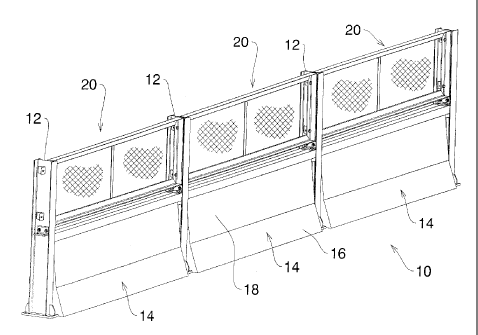Some of the information on this Web page has been provided by external sources. The Government of Canada is not responsible for the accuracy, reliability or currency of the information supplied by external sources. Users wishing to rely upon this information should consult directly with the source of the information. Content provided by external sources is not subject to official languages, privacy and accessibility requirements.
Any discrepancies in the text and image of the Claims and Abstract are due to differing posting times. Text of the Claims and Abstract are posted:
| (12) Patent: | (11) CA 2817563 |
|---|---|
| (54) English Title: | VEHICLE AND PERSONAL BARRIER FOR CONSTRUCTION SITE |
| (54) French Title: | BARRIERE POUR VEHICULES ET PIETONS POUR CHANTIER DE CONSTRUCTION |
| Status: | Granted |
| (51) International Patent Classification (IPC): |
|
|---|---|
| (72) Inventors : |
|
| (73) Owners : |
|
| (71) Applicants : |
|
| (74) Agent: | METHOD LAW PROFESSIONAL CORPORATION |
| (74) Associate agent: | |
| (45) Issued: | 2016-02-09 |
| (22) Filed Date: | 2013-06-04 |
| (41) Open to Public Inspection: | 2014-12-04 |
| Examination requested: | 2013-09-05 |
| Availability of licence: | N/A |
| (25) Language of filing: | English |
| Patent Cooperation Treaty (PCT): | No |
|---|
| (30) Application Priority Data: | None |
|---|
A combined pedestrian and vehicle barrier for a construction site and having upright post members spaced apart, the members having retention means, vehicle barrier members of predetermined length and height and defining support means at each end, engagable with said retention means on the posts, an intermediate fence rail extending between the posts adjacent to the upper extremity of the vehicle barrier members, and, personal fence panels located between the posts, and extending above the intermediate fence rails.
Une barrière combinée pour véhicules et piétons pour un chantier de construction et comportant des éléments de montant verticaux espacés, les éléments comportant des moyens de rétention, des éléments de barrière pour véhicule dune longueur et dune hauteur prédéterminées et définissant des moyens de support à chaque extrémité, pouvant se mettre en prise avec lesdits moyens de rétention sur les montants, une traverse de clôture intermédiaire sétendant entre les montants adjacents à lextrémité supérieure des éléments de la barrière pour véhicule, et des panneaux de clôture personnels situés entre les montants et sétendant au-dessus des traverses de clôture intermédiaire.
Note: Claims are shown in the official language in which they were submitted.
Note: Descriptions are shown in the official language in which they were submitted.

For a clearer understanding of the status of the application/patent presented on this page, the site Disclaimer , as well as the definitions for Patent , Administrative Status , Maintenance Fee and Payment History should be consulted.
| Title | Date |
|---|---|
| Forecasted Issue Date | 2016-02-09 |
| (22) Filed | 2013-06-04 |
| Examination Requested | 2013-09-05 |
| (41) Open to Public Inspection | 2014-12-04 |
| (45) Issued | 2016-02-09 |
There is no abandonment history.
Last Payment of $125.00 was received on 2023-06-02
Upcoming maintenance fee amounts
| Description | Date | Amount |
|---|---|---|
| Next Payment if small entity fee | 2024-06-04 | $125.00 |
| Next Payment if standard fee | 2024-06-04 | $347.00 |
Note : If the full payment has not been received on or before the date indicated, a further fee may be required which may be one of the following
Patent fees are adjusted on the 1st of January every year. The amounts above are the current amounts if received by December 31 of the current year.
Please refer to the CIPO
Patent Fees
web page to see all current fee amounts.
| Fee Type | Anniversary Year | Due Date | Amount Paid | Paid Date |
|---|---|---|---|---|
| Application Fee | $200.00 | 2013-06-04 | ||
| Request for Examination | $400.00 | 2013-09-05 | ||
| Maintenance Fee - Application - New Act | 2 | 2015-06-04 | $50.00 | 2015-05-28 |
| Final Fee | $150.00 | 2015-11-26 | ||
| Maintenance Fee - Patent - New Act | 3 | 2016-06-06 | $50.00 | 2016-04-27 |
| Maintenance Fee - Patent - New Act | 4 | 2017-06-05 | $50.00 | 2017-06-01 |
| Maintenance Fee - Patent - New Act | 5 | 2018-06-04 | $100.00 | 2018-05-30 |
| Maintenance Fee - Patent - New Act | 6 | 2019-06-04 | $100.00 | 2019-06-03 |
| Maintenance Fee - Patent - New Act | 7 | 2020-06-04 | $100.00 | 2020-05-20 |
| Maintenance Fee - Patent - New Act | 8 | 2021-06-04 | $100.00 | 2021-06-01 |
| Maintenance Fee - Patent - New Act | 9 | 2022-06-06 | $100.00 | 2022-06-01 |
| Maintenance Fee - Patent - New Act | 10 | 2023-06-05 | $125.00 | 2023-06-02 |
Note: Records showing the ownership history in alphabetical order.
| Current Owners on Record |
|---|
| DITTA, PAUL LUKE |
| Past Owners on Record |
|---|
| DITTA, JOSEPH |
| DITTA, VITO |